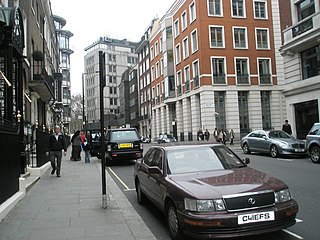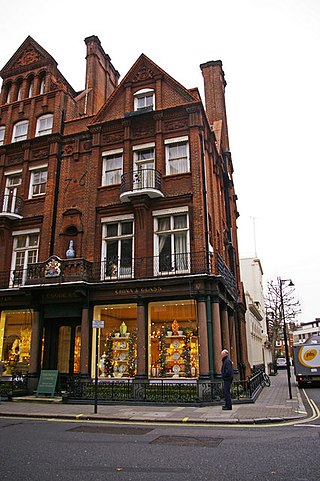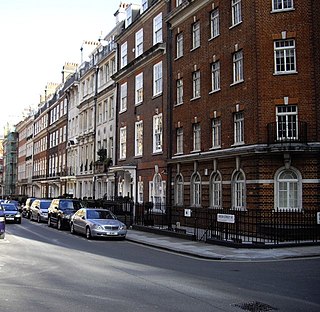
South Audley Street is a major shopping street in Mayfair, London. [1] It runs north to south from the southwest corner of Grosvenor Square to Curzon Street. [2]

South Audley Street is a major shopping street in Mayfair, London. [1] It runs north to south from the southwest corner of Grosvenor Square to Curzon Street. [2]

The street is named after Hugh Audley, whose heirs acquired the land following Sir Thomas Grosvenor's marriage to Mary Davies in 1677. [2] Construction of properties along the street began in 1720, initially with small houses at the north end and larger family residences to the south. [3] This reflected a social convention that was common at this time. [1]
Audley Square was a short abutment at the south end of the street. Unlike other significant squares in Mayfair, it was three sided and had no garden. The first multistorey car park in the City of Westminster opened here in 1962. [4]
Caroline of Brunswick (consort of King George IV) briefly stayed at No. 77 South Audley Street after returning from Italy in 1820. [5] She was considered a popular queen and appeared at the balcony of the house to cheering crowds. [6]
South Audley Street was redeveloped between 1875 and 1900, when most of the smaller buildings to the north were demolished and rebuilt as shops with residences above them. However, several buildings (Nos. 9–16 and 71–75 consecutive) all survive from the 1730s. [5]

The Grosvenor Chapel is a Grade II* listed chapel on South Audley Street, and the only remaining original property on the north part of the street. [1] [7] It was built by Benjamin Timbrell in 1730, and became a chapel of ease for St George's Hanover Square Church in 1831. During World War II it was used by American armed forces. The parents of Arthur Wellesley, 1st Duke of Wellington are buried in the church. [8]
Chesterfield House was a grand house on South Audley Street built by Isaac Ware for Philip Stanhope, 4th Earl of Chesterfield between 1747 and 1750. [5] It was demolished in 1937. [9]
Leconfield House is at the corner of South Audley Street and Curzon Street. It is best known for being the former headquarters of MI5. [10]
Thomas Goode's tableware shop was first established in 1844 at No. 17. [1] It gradually expanded throughout the 19th century; the current premises at Nos. 17–22 was constructed between 1875 and 1891 by Ernest George. [5]

The Qatari embassy is at No 1. [5] It has been Grade II listed since 1970. [11]
Gunsmiths James Purdey & Sons was established at Nos. 57–60 in 1881. [1] [12]
The private member's dining club Harry's Bar was established at No. 26 in 1979. [13]

Soho is an area of the City of Westminster, part of the West End of London. Originally a fashionable district for the aristocracy, it has been one of the main entertainment districts in the capital since the 19th century.

Mayfair is an affluent area in the West End of London towards the eastern edge of Hyde Park, in the City of Westminster, between Oxford Street, Regent Street, Piccadilly and Park Lane. It is one of the most expensive districts in the world.

Regent Street is a major shopping street in the West End of London. It is named after George, the Prince Regent and was laid out under the direction of the architect John Nash and James Burton. It runs from Waterloo Place in St James's at the southern end, through Piccadilly Circus and Oxford Circus, to All Souls Church. From there Langham Place and Portland Place continue the route to Regent's Park.

Belgravia is a district in Central London, covering parts of the areas of the City of Westminster and the Royal Borough of Kensington and Chelsea.

Pall Mall is a street in the St James's area of the City of Westminster, Central London. It connects St James's Street to Trafalgar Square and is a section of the regional A4 road. The street's name is derived from pall-mall, a ball game played there during the 17th century, which in turn is derived from the Italian pallamaglio, literally "ball-mallet".

Hanover Square is a green square in Mayfair, Westminster, south west of Oxford Circus where Oxford Street meets Regent Street. Six streets converge on the square which include Harewood Place with links to Oxford Street, Princes Street, Hanover Street, Saint George Street, Brook Street and Tenderden Street, linking to Bond Street and Oxford Street.

Grosvenor Square is a large garden square in the Mayfair district of Westminster, Greater London. It is the centrepiece of the Mayfair property of the Duke of Westminster, and takes its name from the duke's surname "Grosvenor". It was developed for fashionable residences in the 18th century. In the 20th it had an American and Canadian diplomatic presence, and currently is mixed use, commercial.

Essex Road is a main road in Islington, London. It is part of the A104 and connects Islington High Street with Balls Pond Road via Essex Road railway station.

Curzon Street is located within the Mayfair district of London. The street is located entirely within the W1J postcode district; the eastern end is 200 metres (660 ft) north-east of Green Park underground station. It is within the City of Westminster, running approximately east to west from Fitzmaurice Place past Shepherd Market to Park Lane.
Gunter's Tea Shop in London's Berkeley Square had its origins in a food business named "Pot and Pine Apple" started in 1757 by Italian Domenico Negri. Various English, French and Italian wet and dry sweetmeats were made and sold from the business. In 1777 James Gunter became Negri's business partner, and by 1799 he was the sole proprietor. In the nineteenth and twentieth centuries Gunter's became a fashionable light eatery in Mayfair, notable for its ices and sorbets. In 1815, James sent his son Robert (1783–1852) to study the confectionery trade in Paris. Robert assumed sole control of the business following his father's death in 1819, and took on his cousin John as a partner in 1837.

The 18th century was a period of rapid growth for London, reflecting an increasing national population, the early stirrings of the Industrial Revolution, and London's role at the centre of the evolving British Empire. By the end of the century nearly one million people lived in London, about one tenth of the population of Great Britain. By 1715, London's population reached an estimated 630,000 people, roughly equaling that of Europe's largest city until that time, Paris. Within a few years London itself was the largest city in Europe, reaching 750,000 people by 1760 and 1 million by the end of the century. The average height of a male Londoner was 5'7¼" (171cm) and the average height of a female Londoner was 5'1¾" (157cm).

Piccadilly Arcade runs between Piccadilly and Jermyn Street in central London. It was opened in 1909, having been designed by Thrale Jell, and is a Grade II listed building.

The May Fair Hotel is a luxury hotel on Stratton Street in Mayfair, London, near the site of Devonshire House in Piccadilly. It opened in 1927 with King George V and Queen Mary in attendance. The hotel is now owned by Edwardian Hotels, and Inderneel Singh, son of the chairman and CEO Jasminder Singh, is the managing director.

Conduit Street is a street in Mayfair, London. It connects Bond Street to Regent Street.

Thomas Goode is a china, silverware and glass shop at 19 South Audley Street in Mayfair, London. It holds two royal warrants to supply the British royal household, one from Queen Elizabeth II and the other from the Prince of Wales. The company has been owned by property entrepreneur Johnny Sandelson since 2018 and has since expanded its operations into India opening a store and museum in Mumbai.

Hill Street is a street in Mayfair, London, which runs south-west, then west, from Berkeley Square to Deanery Street, a short approach way from Park Lane. It was developed from farmland in the 18th century. Travelling one block to the east and south sees a fall of about three metres, whereas in the other direction the land rises gradually across six main blocks to beyond the north of Marble Arch. Hill Street's homes gained fashionable status from the outset: grand townhouses seeing use, at first, as seasonal lettings (rentals) and/or longer-term London homes of nobility — later, of other wealthy capitalists as much. Twenty-two, approximately half of its town houses, are listed. Along its course, only Audley Square House departs from townhouse-sized frontage, yet this shares in the street's predominant form of domestic architecture, Georgian neo-classical. Hill Street's public house is the oldest surviving one in Mayfair.

Mount Street is an east–west, quite narrow, archetypal street in the Mayfair district of the City of Westminster, London fronted by many mid-rise buildings, mostly of a narrow frontage. The sides of two very grand hotels flank part of either end of the street. Small, high-end property businesses, investment funds and accountancy businesses punctuate the buildings as well as a row of traditional businesses and conversion-style mansion block apartments or, more generally, authentic such homes.

Stratton Street is a street in the Mayfair district of the City of Westminster, London. It runs from Berkeley Street in the north to Piccadilly in the south.

Green Street is a street in Mayfair, London. It has been built up since the mid-18th century, but most of the current properties date from the late 19th and early 20th century. It has had a number of significant residents, including various members of the British aristocracy, the James Bond author Ian Fleming, and the Beatles.
This is a list of the etymology of street names in the London district of Mayfair, in the City of Westminster. It utilises the generally accepted boundaries of Mayfair viz. Marble Arch/Cumberland Gate and Oxford Street to the north, Regent Street to the east, Piccadilly to the south and Park Lane to the west.
Citations
Sources